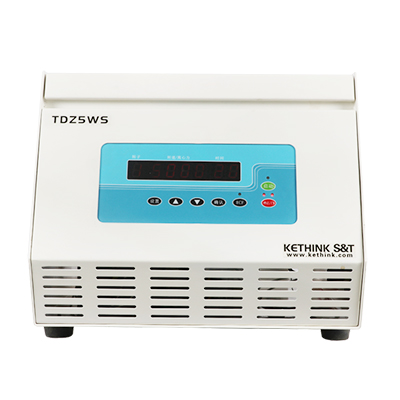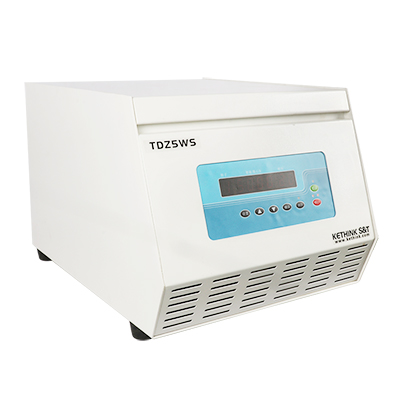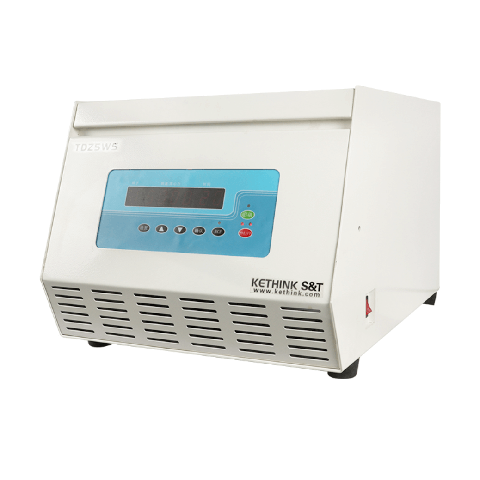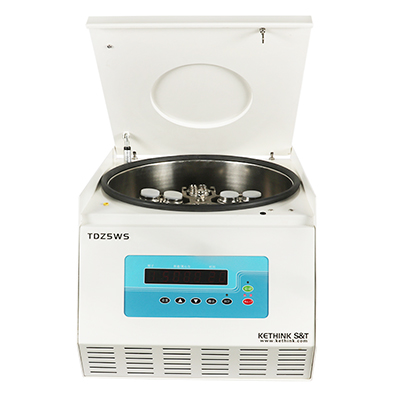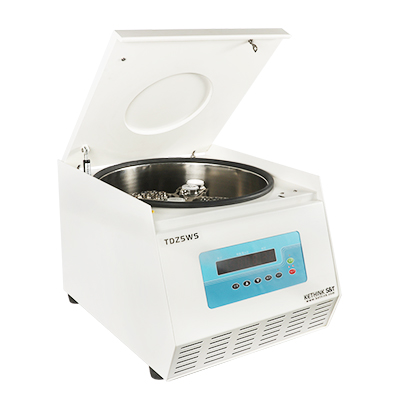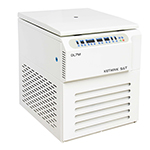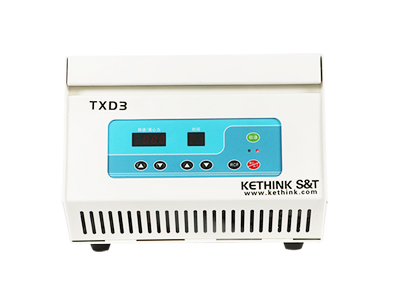Blood plasma centrifuge, low speed 5500rpm
- Model NO: KT-TDZ5WS(LED) KT-TDZ5MR(LCD)
- Max Speed: 5500rpm
- Max RCF: 4390xg
- Max Capacity: 4 * 250ml
- Speed Accuracy: ± 10rpm
- Timer Range: 1-99min/9h59m
- Display: LED/LCD
- Motor: AC frequency conversion
- Power Supply: AC 220V 50HZ 10A
- Power: 450W
- Noise: ≤55dB(A)
- Net Weight: 38Kg
- Device Dimension: 525*420*355mm(L*W*H)
Description
The KT-TDZ5WS is a blood plasma centrifuge that reaches up to 4390xg. For plasma/serum sample extraction and separation, biological component sedimentation. Fast, powerful and affordable. All aspects of blood plasma centrifuge performance are taken into account without compromise. In addition to unparalleled speed (capable of achieving centrifugation speeds up to 5500rpm). Also provides shorter acceleration/deceleration times, low noise operation. Its computer-designed airflow pattern minimizes sample temperature rise during extended high-speed runs.
Blood plasma centrifuge rotor specifications (customized product available)
| No | ITEM | Max Speed(rpm) | Max RCF(xg) | Capacity(ml) | Tube Size(mm) |
| N0.1 | Angle rotor | 5000rpm | 4390xg | 12*10ml | Φ 16*87 |
| N0.2 | Angle rotor | 5000rpm | 2540xg | 6* 15ml(adapt 5/7/10ml) | Φ16*118 |
| N0.3 | Angle rotor | 5000rpm | 3080xg | 12*15ml(adapt 5/7/10ml) | Φ16*118 |
| N0.4 | Angle rotor | 5000rpm | 3515xg | 24 * 15ml(adapt 5/7/10ml) | Φ16*118 |
| N0.5 | Angle rotor | 5000rpm | 3830xg | 30 * 15ml(adapt 5/7/10ml) | Φ16*118 |
| N0.6 | Angle rotor | 5000rpm | 2520xg | 4 *50ml | Φ29*106 |
| N0.7 | Angle rotor | 5000rpm | 2850xg | 6 * 50ml | Φ29*106 |
| N0.8 | Angle rotor | 5000rpm | 2630xg | 4*100ml | Φ37*124 |
| N0.9 | Horizontal rotor body | 4000rpm | 3016xg | Rotor body | – |
| Tube rack | 4000rpm | 3016xg | 4*4*10/15ml | Φ16*135 | |
| Tube rack | 4000rpm | 3016xg | 4*6*10/15ml | Φ16*135 | |
| Tube rack | 4000rpm | 3016xg | 4*8*10/15ml | Φ16*135 | |
| Tube rack | 4000rpm | 3016xg | 4*2*50ml | Φ29*125 | |
| Tube rack | 4000rpm | 3016xg | 4*1 * 100ml | Φ37*124 | |
| Tube rack | 4000rpm | 3016xg | 4* 2 * 100ml | Φ37*124 | |
| NO.10 | Horizontal rotor(Automatic decap) | 4000rpm | 3016xg | 24/32 hole * 5/7ml blood collection tube | Φ13*95 |
| N0.11 | Horizontal hanging cup rotor | 4000rpm | 3215xg | 4*12*5/7ml | Φ13*95 |
| N0.12 | Horizontal hanging cup rotor | 4000rpm | 3215xg | 4*18*5/7ml | Φ13*95 |
| N0.13 | Horizontal rotor | 4000rpm | 3016xg | 4 *250ml(4 cups) | Φ64*125 |
| N0.14 | Horizontal ELISA PLATE rotor | 4000rpm | 2310xg | 2*2* 48hole |
Related Product
Refrigerated Blood Bag Centrifuge
Blood Bank Cell Washer Centrifuge
How to separate plasma from blood without centrifuge ?
Plasma or serum can be separated from whole blood without centrifugation by allowing the blood to just let stand. By gravity all the cells will settle down in due course of time (if time is not the question). If you allow the citrated blood to stand in a tube, the supernatant is the plasma.
Related Video: How do you separate plasma and blood from a centrifuge?
Separating plasma from whole blood centrifuge:
Blood is usually separated from plasma through centrifugation. The physical force from continuous revolutions pushes the denser, heavier particles to the outer edges of the sample resulting in three layers of different densities: RBCs, a mixture of WBCs and platelets, and plasma. The addition of a density separation medium can also cause the isolation of mononuclear cells and granulocytes from human blood.
Centrifugation and other blood separation techniques may leave behind residual RBCs, which can extend sort times and impede subsequent cell separation.
Plasma preparation
Collect whole blood into commercially available anticoagulant-treated tubes e.g., EDTA-treated (lavender tops) or citrate-treated (light blue tops). Heparinized tubes (green tops) are indicated for some applications; however, heparin can often be contaminated with endotoxin, which can stimulate white blood cells to release cytokines. Cells are removed from plasma by centrifugation for 10 minutes at 1,000–2,000 x g using a refrigerated centrifuge. Centrifugation for 15 minutes at 2,000 x g depletes platelets in the plasma sample.
The resulting supernatant is designated plasma. Following centrifugation, it is important to immediately transfer the liquid component (plasma) into a clean polypropylene tube using a Pasteur pipette. The samples should be maintained at 2–8°C while handling. If the plasma is not analyzed immediately, the plasma should be apportioned into 0.5 ml aliquots, stored, and transported at –20°C or lower. It is important to avoid freeze-thaw cycles. Samples which are hemolyzed, icteric, or lipemic can invalidate certain tests. There are other commercially available tubes for blood sample collection. Invitrogen has not evaluated some of these tubes for compatibility with our ELISA kits.
How to centrifuge blood for serum ?
Collect whole blood in a covered test tube. If commercially available tubes are to be used, the researcher should use the red topped tubes. These are available from Becton Dickinson (BD). BD’s trade name for the blood handling tubes is Vacutainer. After collection of the whole blood, allow the blood to clot by leaving it undisturbed at room temperature. This usually takes 15–30 minutes. Remove the clot by centrifuging at 1,000–2,000 x g for 10 minutes in a refrigerated centrifuge.
The resulting supernatant is designated serum. Following centrifugation, it is important to immediately transfer the liquid component (serum) into a clean polypropylene tube using a Pasteur pipette. The samples should be maintained at 2–8°C while handling. If the serum is not analyzed immediately, the serum should be apportioned into 0.5 ml aliquots, stored, and transported at –20°C or lower. It is important to avoid freeze-thaw cycles because this is detrimental to many serum components. Samples which are hemolyzed, icteric or lipemic can invalidate certain tests.
The commercially available serum tubes are as follows:
- Red: No anticoagulant.
- Red with black: Treated with gel to help to separate the clot (not evaluated).
The commercially available plasma tubes are as follows:
- Blue: Treated with citrate.
- Green: Treated with heparin.
- Lavender: Treated with EDTA.
- Yellow: Treated with potassium oxalate/sodium fluoride (not evaluated).
- Grey: Treated with potassium oxalate/sodium fluoride (not evaluated).

